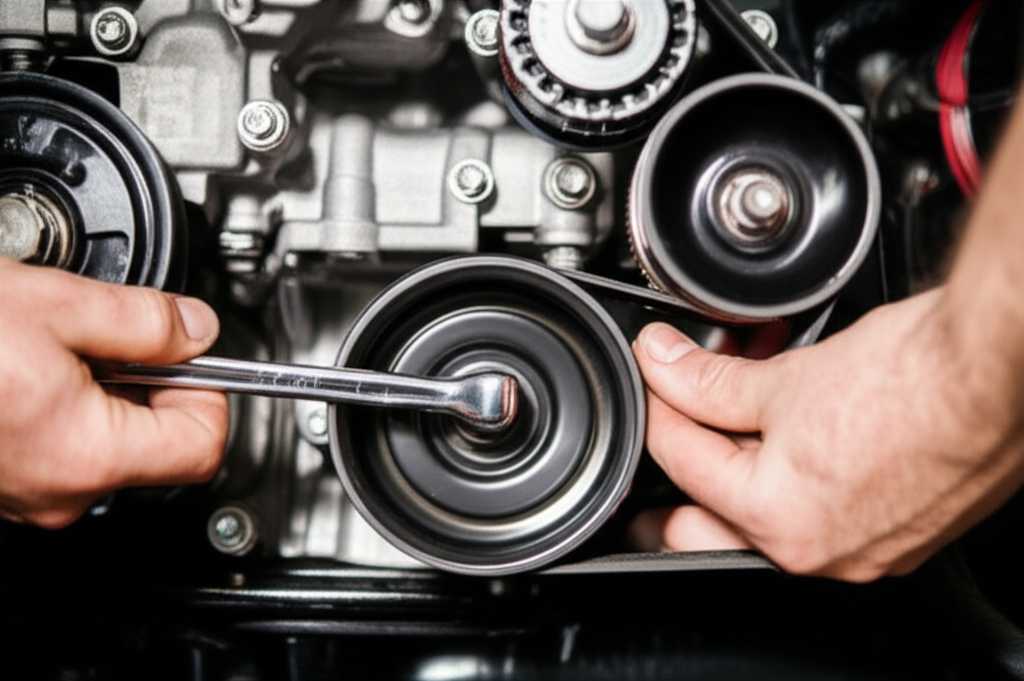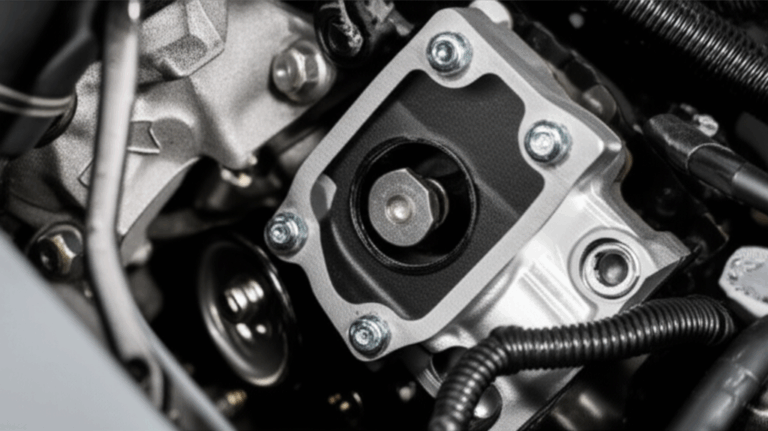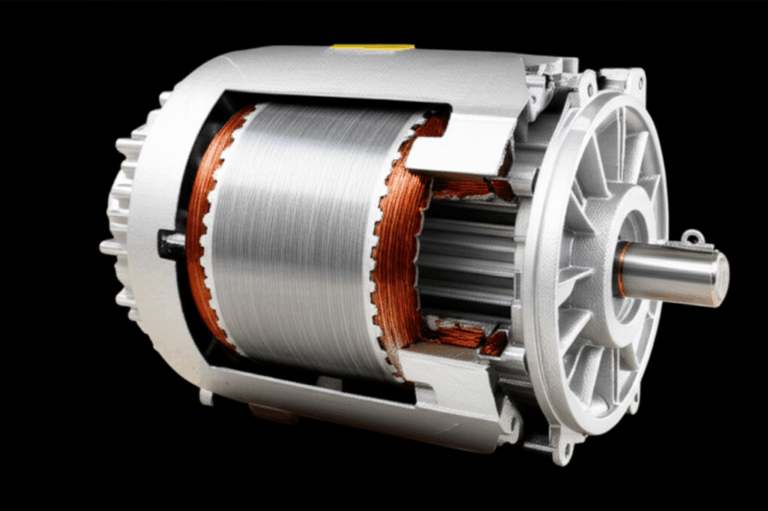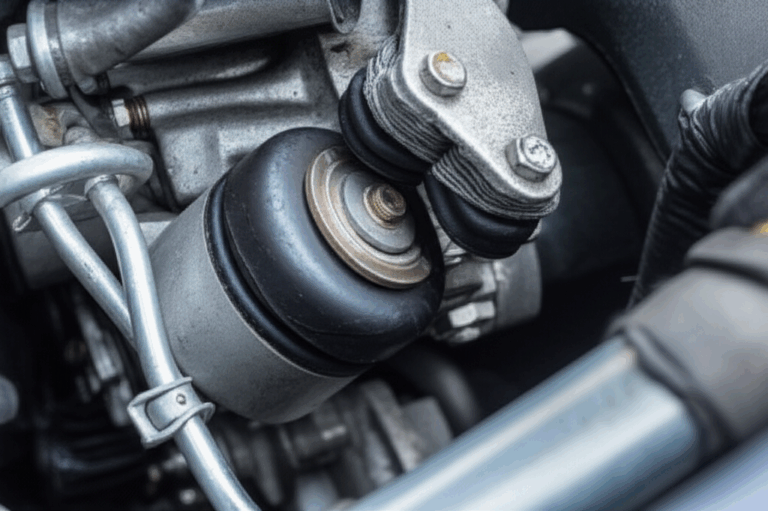
How to Tell if a Motor is Seized: Definitive Signs & Diagnostic Steps
Table of Contents
- What I Mean By a “Seized Engine”
- Immediate Signs Your Engine Might Be Seized
- The “No Crank” Symptom
- Clicking Noise From the Starter
- Burning Smell or Smoke
- Engine Locked Up or Won’t Turn Manually
- Step-by-Step Diagnostic Guide to Confirm a Seized Engine
- Step 1: Check the Battery and Starter
- Step 2: Inspect Engine Fluids
- Step 3: Try Turning the Engine Manually
- Step 4: Rule Out Seized Accessories
- Step 5: Pull Spark Plugs to Check for Hydro-lock
- Common Causes of Engine Seizure
- Oil Starvation
- Overheating
- Hydro-lock
- Catastrophic Component Failure
- Rust or Corrosion From Storage
- What to Do After You Confirm a Seized Engine
- Professional Diagnosis
- Repair vs Replace and What It Costs
- How I Make the Call on Keep or Scrap
- Prevention: How I Keep My Engines From Seizing
- Electric Motors and EVs: A Quick Note
- FAQs
- Conclusion: Don’t Ignore the Signs
I still remember the first time I faced a seized engine. A neighbor’s old truck rolled into my driveway on a flatbed. It wouldn’t start. He swore the battery was new. I turned the key. The starter clicked hard. The crankshaft didn’t move a hair. No crank. No life. I pulled the spark plugs, grabbed a breaker bar, and put it on the crankshaft pulley bolt. Nothing. The engine felt like someone welded the pistons to the cylinder walls. We drained the oil and found metal shavings. That was the day I learned to stop guessing and start testing. If you’re here, you’re probably staring at a car that won’t start and you want to know if the motor is seized. I’ll walk you through the steps I use. I’ll call out the signs that matter and the traps that waste time and money.
What I Mean By a “Seized Engine”
When I say a motor is seized, I mean the internal parts have locked together. The crankshaft can’t rotate. Pistons won’t move up and down in the cylinders. Bearings on the crank or connecting rods may have overheated. They can weld to journals or smear and bind. Sometimes a piston sticks to the cylinder wall. Other times a broken connecting rod or a snapped timing chain jams everything. The result is the same. The engine won’t rotate by the starter or by hand.
Why is this critical? Because a seized engine usually points to catastrophic damage. Oil starvation is the usual suspect. Overheating runs a close second. Hydro-lock can do it in one bad moment. Once an engine locks, you’re often staring at an engine rebuild or replacement. There are rare cases where you can free it. I’ve freed light rust with a penetrating oil soak and careful turning. If metal fused to metal from heat or a rod bent from hydro-lock, you’re not reviving it with a magic trick.
Immediate Signs Your Engine Might Be Seized
Before I pull tools, I listen, sniff, and look. A few symptoms get my attention fast.
The “No Crank” Symptom
You turn the key or push the start button. The starter motor engages. Maybe you hear a clunk or a heavy click. The engine doesn’t spin. The serpentine belt doesn’t move. The crank pulley sits dead still. That’s a red flag.
I always rule out basic electrical issues first. A dead battery can mimic a seized engine because the starter can’t supply enough torque. Here’s how I separate them:
- Headlights bright with no dimming during crank attempts suggests the engine isn’t drawing current because it isn’t turning.
- Headlights dim hard or dash lights drop off points to heavy load. That can be a high compression engine trying to turn or a locked one resisting the starter.
- If a known-good battery and solid connections still give me a heavy clunk with no crank, I start thinking seizure.
Clicking Noise From the Starter
A rapid click usually screams low voltage or a bad starter solenoid. A single heavy clunk can point to a seized engine if you know the battery and cables are solid. I’ve heard both. When I hear rapid machine-gun clicks, I grab a voltmeter. When I hear one solid click with no rotation, I reach for a breaker bar.
Burning Smell or Smoke
If someone kept the key at “start” while the engine wouldn’t turn, the starter gets hot. You might smell burning insulation or see a wisp of smoke near the starter motor or the battery cables. I’ve also smelled burnt oil when bearings have overheated. If I smell hot metal and burnt oil, I don’t keep cranking it. That’s how you turn expensive into even more expensive.
Engine Locked Up or Won’t Turn Manually
This is the clincher. If I can’t turn the engine by hand at the crankshaft pulley bolt, the motor is likely seized. Sometimes it moves an inch then hits a brick wall. That can be a bent connecting rod from hydro-lock or a broken component lodged inside. If it turns smoothly, it isn’t seized. That means I should chase other no-start issues like ignition, fuel, or compression.
Step-by-Step Diagnostic Guide to Confirm a Seized Engine
I follow a simple routine. It saves time and avoids guessing. You can do most of this with basic tools.
Step 1: Check the Battery and Starter
- Test the battery. I use a multimeter. I want to see around 12.6 volts at rest and over 10 volts during crank. If it drops under 9.6 volts on crank, the battery or the load is suspect.
- Inspect battery terminals. Corrosion and loose clamps are sneaky thieves.
- Try a jump from a known-good source. If nothing changes, the starter may be fine and the engine may be jammed.
- Listen to the starter. A healthy whir with no engine movement points to a failed starter drive. A single heavy clunk with no movement and a healthy battery points to a locked engine.
If the battery is perfect and the cables are clean and tight and the starter still can’t rotate the engine, that’s a bad sign.
Step 2: Inspect Engine Fluids
I pull the dipstick before I wrench anything else.
- Oil level: If it’s low or bone dry, oil starvation jumps to the top of my list.
- Oil condition: Milky oil can mean coolant contamination from a bad head gasket. That can cause hydro-lock or bearing failure. Sparkly metallic flecks in the oil tell me metal is moving around. That’s bad news for bearings and cylinder walls.
- Coolant level: I check the reservoir and the radiator if the engine is cold and safe to open. Low coolant with no obvious leaks can point to internal leaks. Oil floating in the coolant or coolant in the oil means cross contamination.
I’ve pulled drain plugs and watched glitter pour out. When I see metal shavings in oil, I expect bearing failure or serious internal damage.
Step 3: Try Turning the Engine Manually
This is the definitive test I use.
- Put a socket on the crankshaft pulley bolt. Use a breaker bar. Don’t use a ratchet that can break or slip.
- Rotate in the engine’s normal direction. Most engines spin clockwise when viewed from the front but confirm for your model.
- Apply steady pressure. Don’t jump on the bar. If it’s going to move, it should move with firm pressure.
Three outcomes tell me a lot:
- No movement at all: Strong indicator of a seized engine.
- Moves a little then stops dead: I suspect a bent connecting rod, a dropped valve, or debris jammed between the piston and head. I’ve seen this after hydro-lock when water or coolant filled a cylinder. Since fluid doesn’t compress, the crank spins until it hits the incompressible fluid then stops cold.
- Turns smoothly: The engine is not seized. Time to chase other starting issues like fuel system, ignition system, timing, or compression.
Step 4: Rule Out Seized Accessories
A seized accessory can fool you. If the AC compressor, alternator, water pump, or an idler pulley locks up, the serpentine belt can hold the crank pulley. It feels like the engine is seized even though it isn’t.
I do this:
- Remove the serpentine belt.
- Spin each pulley by hand. If one feels gritty, stiff, or won’t spin, you found a problem. An AC compressor or power steering pump can seize and mimic an engine lock.
- Try turning the engine by hand again with the belt off.
I once had an alternator pulley seize so hard that the belt smoked. The engine itself spun fine with the belt removed. That little check saved a tow and a teardown.
Step 5: Pull Spark Plugs to Check for Hydro-lock
Hydro-lock is a heartbreaker. Water, coolant, or raw fuel enters a cylinder. Since fluids don’t compress, the piston can’t complete its stroke. The crankshaft stops. The starter clunks. Sometimes a connecting rod bends before the engine seizes.
Here’s what I do:
- Remove all the spark plugs.
- Look down into the cylinders with a light. If I see liquid, I’ve found my suspect. Coolant smells sweet. Fuel smells like fuel. Water looks like water.
- Turn the engine slowly by hand with the plugs out. If fluid sprays out of a spark plug hole, you had a hydro-lock. If the engine now turns freely, you can confirm the cause and inspect for damage.
If I see coolant, I suspect a blown head gasket or a cracked head or a cracked block. If I see water in an engine that drove through a deep puddle, that’s a classic hydrolock situation. If I see raw fuel, a stuck injector can flood a cylinder on some engines.
Common Causes of Engine Seizure
Once I confirm seizure or strong signs of it, I work backward to understand why. The cause guides the fix and the cost.
Oil Starvation
This is the big one. Industry observations suggest oil starvation accounts for a majority of seized engines. I’ve seen numbers around 60 to 70 percent. It makes sense. Oil is the lifeblood. No oil, no lubrication. Bearings overheat and melt. Pistons scuff and seize to cylinder walls. Causes include:
- Low oil level from leaks or consumption
- Skipped oil changes that turn oil into sludge
- Oil pump failure
- Blocked oil pickup or oil filter collapse
- Wrong oil viscosity on some engines
Symptoms I’ve seen:
- Oil pressure warning light before failure
- Knocking or ticking before the final stop
- Metal shavings in oil
- Burnt oil smell
Overheating
Heat expands metal. If the engine overheats, clearances vanish. Pistons swell and scrape. Cylinder heads warp. Bearings lose their film of oil. Engines bind and lock.
Common reasons:
- Coolant leaks
- Failed water pump
- Thermostat stuck closed
- Radiator clogged
- Cooling fan not working
- Low coolant from neglect
Clues:
- Temperature gauge pinned or engine overheating indicator lit
- Steam under the hood
- Sweet smell from coolant
- Milky oil from coolant intrusion
- Warped head and blown head gasket
Hydro-lock
Water, coolant, or fuel in a cylinder stops pistons in their tracks. I’ve seen hydrolock from:
- Driving through deep water
- Blown head gasket leaking coolant into a cylinder
- Cracked head or block
- Stuck injector dumping fuel
- Turbocharger failure pushing oil or coolant into intake on turbo engines
- Diesel engines can hydrolock easily because of high compression
Typical outcome:
- Bent connecting rod
- Starter clunk with no crank
- Engine turns partially then stops
- Liquid found on spark plugs or in cylinders
Catastrophic Component Failure
Sometimes a part fails and takes the whole party down with it.
- Thrown connecting rod
- Disintegrated piston
- Spun bearing that seized to the crankshaft
- Timing chain or belt failure where valves contact pistons and jam the engine
- Camshaft seizure on engines with oil starvation to the head
You often hear a loud bang or grinding before the engine dies. Sometimes you don’t get a warning. I’ve seen a cracked timing chain guide scatter plastic and steel bits into the chain then lock it up.
Rust or Corrosion From Storage
Engines that sit for years can lock from rust. Moisture sneaks into cylinders through open valves or poor storage. Pistons rust to cylinder walls. Bearings corrode. When I help folks revive classics or long-parked cars, I go slow and soak cylinders with penetrating oil before I try to rotate anything.
I’ve pulled engines from long-term storage and found light rust that broke free with patience. I’ve also found deep rust that needed a full teardown and bore to fix cylinder wall scoring.
A quick real-world note. The “Cash for Clunkers” program back in 2009 used sodium silicate to intentionally jam engines. That chemical turned into glassy deposits inside when run with no oil and it locked engines solid. It shows how quickly an engine can be rendered unusable when lubrication fails or foreign material interferes.
What to Do After You Confirm a Seized Engine
If your motor is seized, take a breath. There’s a right way to move forward. I’ve made the wrong call before and it cost me. Here’s how I approach it now.
Professional Diagnosis
If the engine won’t turn by hand and the basic checks point to internal damage, I call in or take it to a professional mechanic. A pro can:
- Perform a deeper inspection without causing more damage
- Use a borescope through a spark plug hole to look at cylinder walls and pistons
- Drop the oil pan to check bearings and look for debris
- Pressure test the cooling system
- Pull diagnostic trouble codes for related issues like misfires, coolant temperature sensor faults, or oil pressure issues
The goal is to judge if the block is salvageable. If the block is cracked or a rod exited the engine block, I don’t waste time contemplating a rebuild.
Repair vs Replace and What It Costs
I weigh three paths: rebuild, used/reman replacement, or new replacement.
- Engine rebuild: I see prices from about $2,000 to over $7,000 depending on labor rates, parts, and whether machine work is needed. If the engine block and crankshaft journals are still in spec or repairable, a rebuild can give you like-new life. It’s labor heavy.
- Used or remanufactured engine: I’ve paid between $2,500 and $6,000+ installed. It depends on the vehicle and availability. Reman engines often come with a warranty. Used engines are cheaper but riskier unless you trust the source and see a compression test and oil pressure data.
- New engine replacement: $4,000 to $10,000+ is not unusual for modern vehicles. Many older cars aren’t worth that much, so the vehicle ends up totaled.
I also consider the ripple effects. If the radiator clogged and cooked the engine, I budget for a cooling system overhaul. If oil starvation took out bearings, I want to inspect the oil pump and pickup. Don’t replace a heart and ignore the arteries.
How I Make the Call on Keep or Scrap
I balance:
- Vehicle value and condition
- How long I plan to keep it
- Warranty options on engines or rebuilds
- Hidden costs like accessories, gaskets, hoses, fluids, and mounts
- My trust in the shop doing the work
If the car is clean, the body and transmission are solid, and I love it, I lean toward a reman engine with a warranty. If the car has high miles and needs everything, I cut my losses. Sometimes the best tool is a calculator and a cold drink.
Prevention: How I Keep My Engines From Seizing
I’m big on prevention. It’s cheaper than repairs and a lot less heartbreaking.
- Oil changes on schedule: Fresh oil protects bearings and pistons. I use the oil grade the manufacturer recommends. I replace the filter every time. I check oil level monthly and before road trips.
- Watch the dashboard: I take the oil pressure warning light and engine overheating indicator seriously. If the oil light flickers or the temperature gauge climbs, I stop and diagnose. I don’t limp it home. That’s how you weld bearings.
- Cooling system maintenance: I replace coolant every 2 to 5 years depending on the vehicle. I inspect hoses, the radiator, and the water pump. I make sure the cooling fan works. If the coolant level drops, I find the leak.
- Fix leaks early: Oil leaks can drain a sump over time. Coolant leaks cause overheating. A small drip can become a big bill.
- Timing belt or chain service: If your engine has a timing belt, you must replace it on schedule. A snapped belt can let valves hit pistons on interference engines. That can bend valves and seize a motor. Timing chains last longer but still need oil pressure and tensioner health. Listen for rattles.
- Air and fuel system care: A clogged intake or failing fuel system won’t seize an engine on its own. They can cause misfires and weird running that hide other issues. Good maintenance keeps the big picture clear.
- Storage prep: If a car will sit, I change the oil before storage. I stabilize the fuel. I consider fogging oil to protect cylinders. I seal openings to keep moisture out. I turn the engine by hand now and then if it’s safe to do so.
Electric Motors and EVs: A Quick Note
I focus mostly on internal combustion engines here. People also ask me how to tell if an electric motor is seized. The idea is similar. The rotor won’t spin because something binds. Causes differ though.
In electric motors I’ve diagnosed:
- Bearing failure that locks the rotor
- Foreign debris jamming the rotor
- Overheating that distorts parts
- Locked rotor condition from electrical faults that isn’t physical seizure but feels like it if you try to spin it
If you work with electric motors or EV components, you’ll see the terms rotor and stator a lot. The core stacks in these machines use laminations to reduce eddy current losses and heat. The quality and design of the stator core laminations matter for efficiency and heat control. Poor heat control can shorten bearing life and encourage failure. The rotor core laminations also affect how the rotor behaves under load and heat. If you’re rebuilding or sourcing parts for an industrial motor, pay attention to the electrical steel laminations used. They influence performance and durability. For broader motor builds and repairs, understanding the role of motor core laminations helps you match parts to duty cycles and avoid premature failures that can feel like seizure in the field.
On EV drivetrains, software faults can throw the system into a protective mode. It can feel like a seized motor even though it’s an electrical issue. Always pull codes from the inverter or ECU and follow the safety procedures for high-voltage systems. Don’t start wrenching on orange cables unless you’re certified and geared up.
FAQs
Q: Can a seized engine be fixed?
A: Sometimes. If it locked from light rust, careful soaking and hand turning can free it. If it seized from oil starvation and welded bearings, you’re looking at a rebuild or replacement. If hydro-lock bent a connecting rod, the engine needs internal repair at a minimum. A proper teardown tells the truth.
Q: How much does it cost to fix a seized engine?
A: It varies with the cause and the vehicle. A rebuild can run $2,000 to $7,000+. A used or remanufactured engine installed often sits between $2,500 and $6,000+. A new engine can hit $4,000 to $10,000+. Add supporting parts like gaskets, fluids, and cooling system components.
Q: What does a seized engine sound like?
A: Often you hear a single heavy click or clunk when you turn the key. The starter tries but the engine doesn’t move. You might hear nothing if the starter or battery is weak. If the engine failed while running, you might have heard a loud bang or grinding before it died.
Q: Is it worth repairing a seized engine?
A: It depends. If the car is in great shape and you plan to keep it, a reman engine with a warranty can make sense. If the car has high miles and needs suspension, brakes, and tires, a $5,000 engine won’t pencil out. I compare total repair cost to the vehicle’s value and my plans for it.
Q: Can you prevent an engine from seizing?
A: Yes in many cases. Change oil on time. Fix leaks. Watch temperatures and oil pressure. Maintain the cooling system. Replace timing belts on schedule. Prep engines for storage. Most seized engines I’ve seen started with ignored warnings or deferred maintenance.
Conclusion: Don’t Ignore the Signs
When a car won’t crank and the starter just clicks, your gut drops. I’ve been there. Don’t guess. Run the tests. Check the battery. Inspect the oil and coolant. Try turning the crank with a breaker bar. Pull the serpentine belt to rule out seized accessories. Remove the spark plugs and look for fluid in the cylinders. Those simple steps separate a dead battery from a dead engine. If the motor is seized, get a professional diagnosis and make a clear-eyed plan. Sometimes you rebuild. Sometimes you replace. Sometimes you walk away.
I’ll leave you with this. Engines rarely seize out of nowhere. The oil pressure light flickers. The temperature gauge creeps up. The coolant level keeps dropping. The oil looks like coffee with cream. Your nose smells something burning. Pay attention to those whispers. They can save an engine and your wallet.








